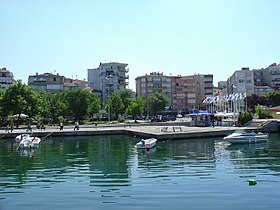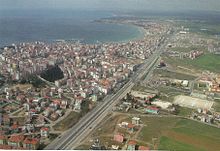Silivri
| Silivri | |||
|
|||

|
|||
| Basic data | |||
|---|---|---|---|
| Province (il) : | Istanbul | ||
| Coordinates : | 41 ° 4 ' N , 28 ° 15' E | ||
| Residents : | 137,861 (2012) | ||
| Telephone code : |
(+90) 212 (European part) (+90) 216 (Asian part) |
||
| Postal code : | 34 xxx | ||
| License plate : | 34 | ||
| Structure and administration (as of 2019) | |||
| Mayor : | Volkan Yılmaz ( MHP ) | ||
| Website: | |||
| Silivri district | |||
| Residents : | 180,524 (2017) | ||
| Surface: | 869.51 km² | ||
| Population density : | 208 inhabitants per km² | ||
| Kaymakam : | Ahmet Mesut Demirkol | ||
| Website (Kaymakam): | |||
Silivri is the district center of the district of the same name in the Turkish province of İstanbul on the European side. The district of Silivri has 180,524 inhabitants (as of 2017).
history
In archaic times the settlement was settled by Dorians under the name of Selymbria (gr. Σηλυμβρία) . Around 500 BC Selymbria becomes part of the Achaemenid Empire . 341 BC The place fell to King Philip II of Macedonia. 200 BC The Celtic Galatians settled there. As part of Thrace , the city became part of the Roman Empire by 46 AD at the latest, like all of Thrace . After its final division in 395, Selymbria then belonged to the Byzantine Empire . The city name was temporarily changed to Eudoxiopolis by Emperor Arcadius (377-408, emperor from 395) after his wife Aelia Eudoxia . In 447 the city was sacked by the Huns and was repeatedly affected during sieges of Constantinople until the 9th century. In 805 Selymbria became part of the Bulgarian Empire. In 812 the Byzantines recaptured Selymbria. In the 10th century Selymbria was the seat of an archbishop. The titular diocese Selymbria of the Roman Catholic Church goes back to the Archdiocese .
Selymbria first became Ottoman in 1399, but was returned to the Byzantines in 1403. Immediately after the fall of Constantinople in May 1453, Selymbria also capitulated and again fell under Ottoman rule.
In the Russo-Ottoman War of 1877, Silivri was occupied by Russian troops, but again Ottoman after the war. With the outbreak of the Balkan Wars , Silivri was temporarily occupied by Bulgaria from 1912 to 1913. Later, after the end of the First World War , Silivri was occupied by Greek troops between July 20, 1920 and October 22, 1922. The Greek troops were then followed by Italian troops for a whole eight days. Silivri has been part of the Turkish Republic since 1924.
In 2008 the campus of the Silivri correctional facility was built as Europe's largest prison complex.
Attractions
Silivri is located on the main road from Istanbul to Tekirdağ on the coast of the Marmara Sea . The coast around Silivri is built on with Istanbul weekend houses.
The Byzantine wall of Anastasios I (491-518 AD) began in Silivri and reached approximately as far as Kıyıköy on the Black Sea . Parts of the wall have been preserved.
The remains of the Byzantine Episcopal Church of Selymbria, which were still visible in Silivri before the First World War and which were described and photographed by Friedrich Schrader , have since been removed and have disappeared.
The promenade , on which mainly fish restaurants are located, has been renovated for several years . It has now developed into a lively place in the city.
Personalities
- Nektarios von der Pentapolis (1846–1920), Greek Orthodox bishop and saint
- Rupen Sevag (1885–1915), writer and victim of the Armenian genocide
Web links
Individual evidence
- ^ Turkish Institute for Statistics, 2012 ( Memento from February 20, 2013 on WebCite ), accessed May 9, 2015
- ↑ https://www.sha.com.tr/gundem/silivrinin-nufusu-aciklandi-h22204.html
- ↑ Silivri'nin nüfusu açıklandı. Retrieved January 20, 2020 (Turkish).
- ↑ Otto Feld: Once again Alexios Apokaukos and the Byzantine Church of Selymbria (Silivri) . In: Byzantion 37, 1967, pp. 57-65.



